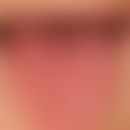Synonym(s)
DefinitionThis section has been translated automatically.
Polidocanol or Macrogollaurylether is effective as a surface anaesthetic (see also local anaesthetics), antipruriginosum, vein sclerosing agent and belongs chemically to the polyaethylene glycols (PEG).
Pharmacodynamics (Effect)This section has been translated automatically.
Polidocanol belongs to the group of detergent sclerosing agents. Its injection leads to a mixture of sclerosing agent with blood, to endothelial cell lysis and finally to obstruction of the injected vessel.
You might also be interested in
Standard concentrationThis section has been translated automatically.
- 3-5% in creams, lotions (see e.g. Optiderm), shaking mixtures and oil baths (antipruriginous effect lasts for about 4 hours)
- 0.5-3% in injection solutions for vein sclerotherapy
Undesirable effectsThis section has been translated automatically.
Recipe(s)This section has been translated automatically.
Head tincture containing polidocanol
Polidocanol zinc oxide shaking mixture 3/5 or 10 % (NRF 11.66.
Polidocanol cream 2-5% (The NRF monographs 2 standardized formulations with lauromacrogol 400 in a hydrophobic base, NRF 11.119. and NRF 11.120. The standardized formulations contain a low-water base. The hydrophilic portion is only 20 % (10 % water and 10 % propylene glycol) instead of 70 % as in the hydrophobic base cream DAC).
PreparationsThis section has been translated automatically.
Thesit, Aethoxysclerol, Recessan, Balneum Hermal plus®, Optiderm®





